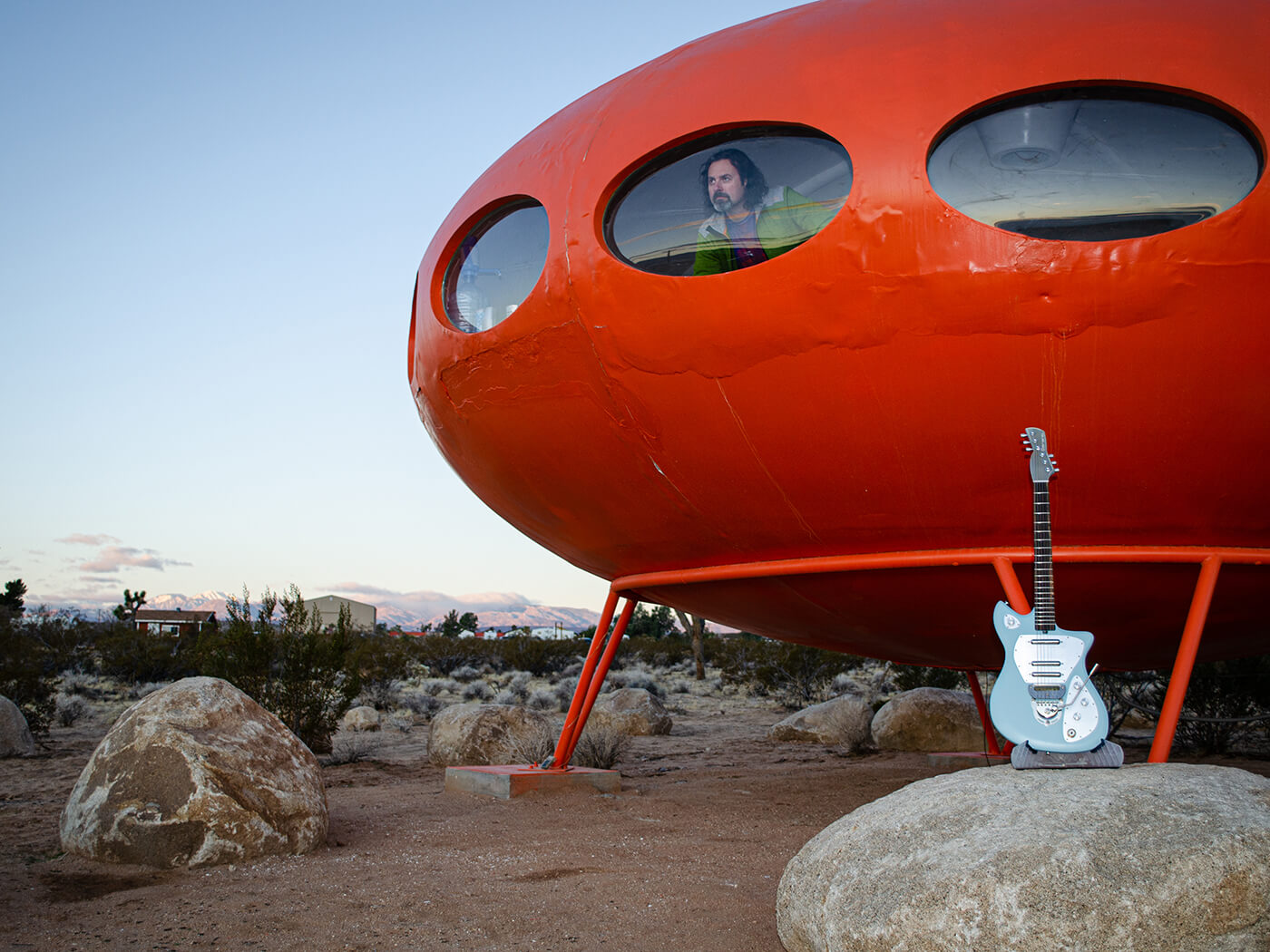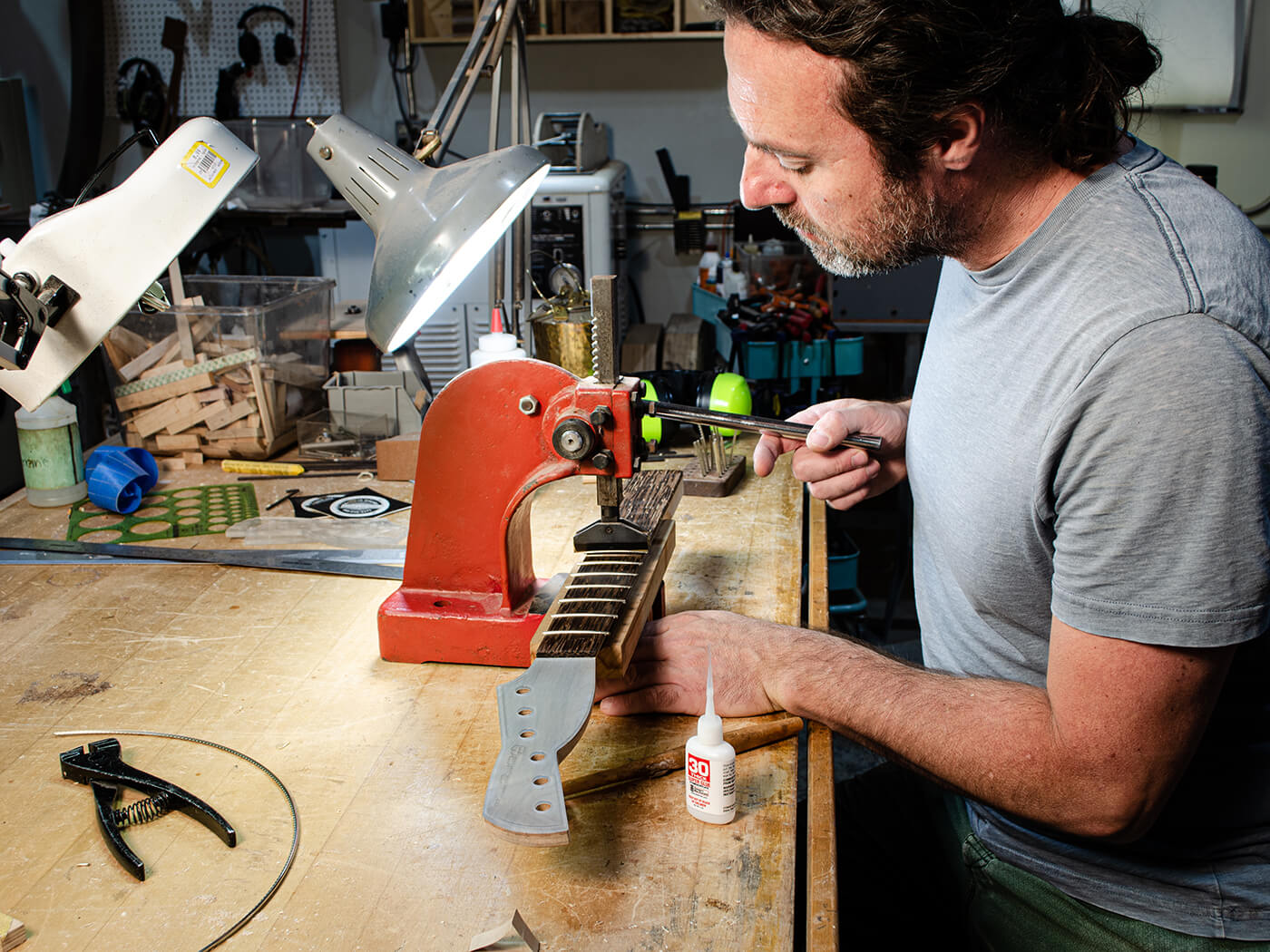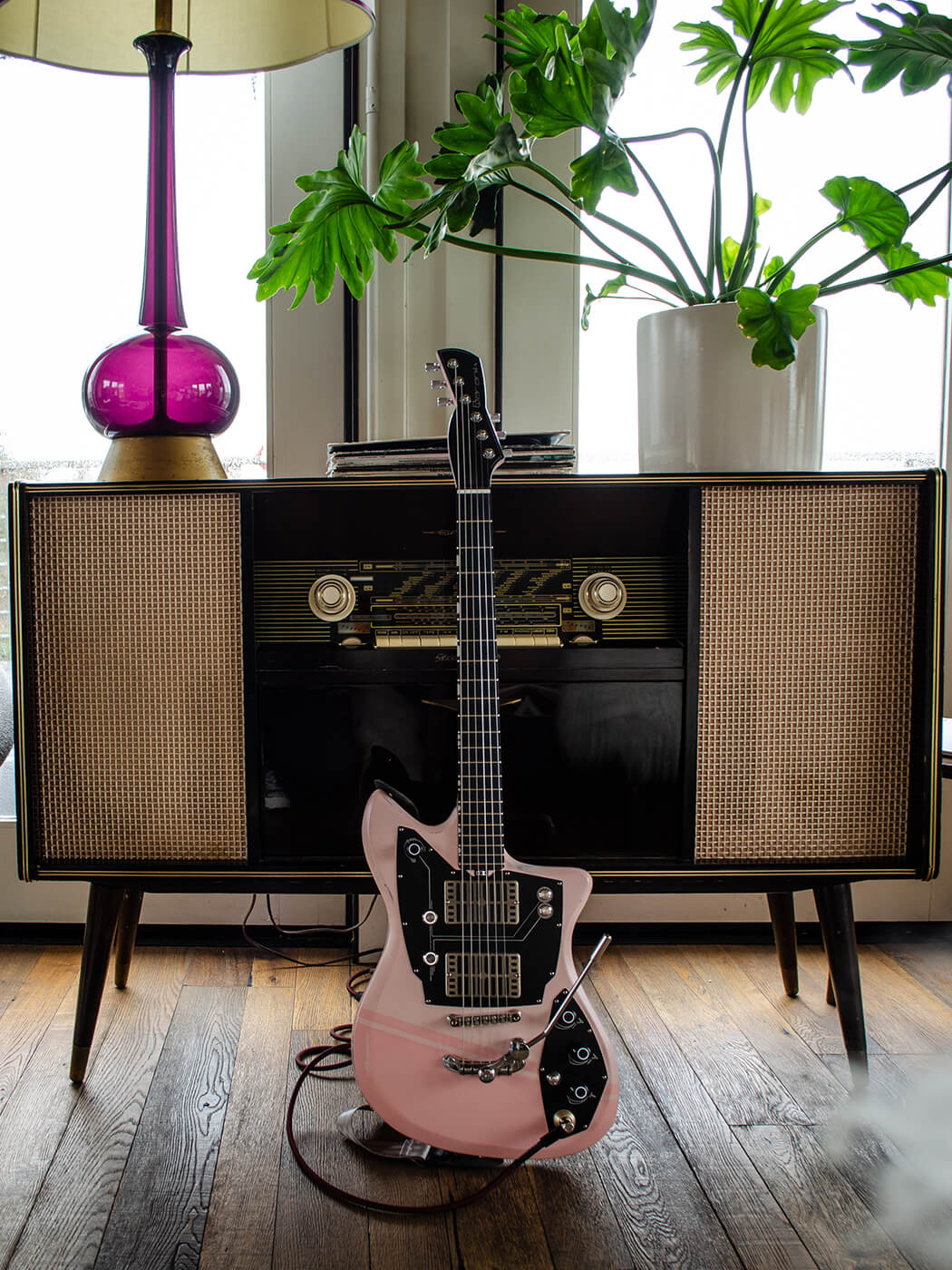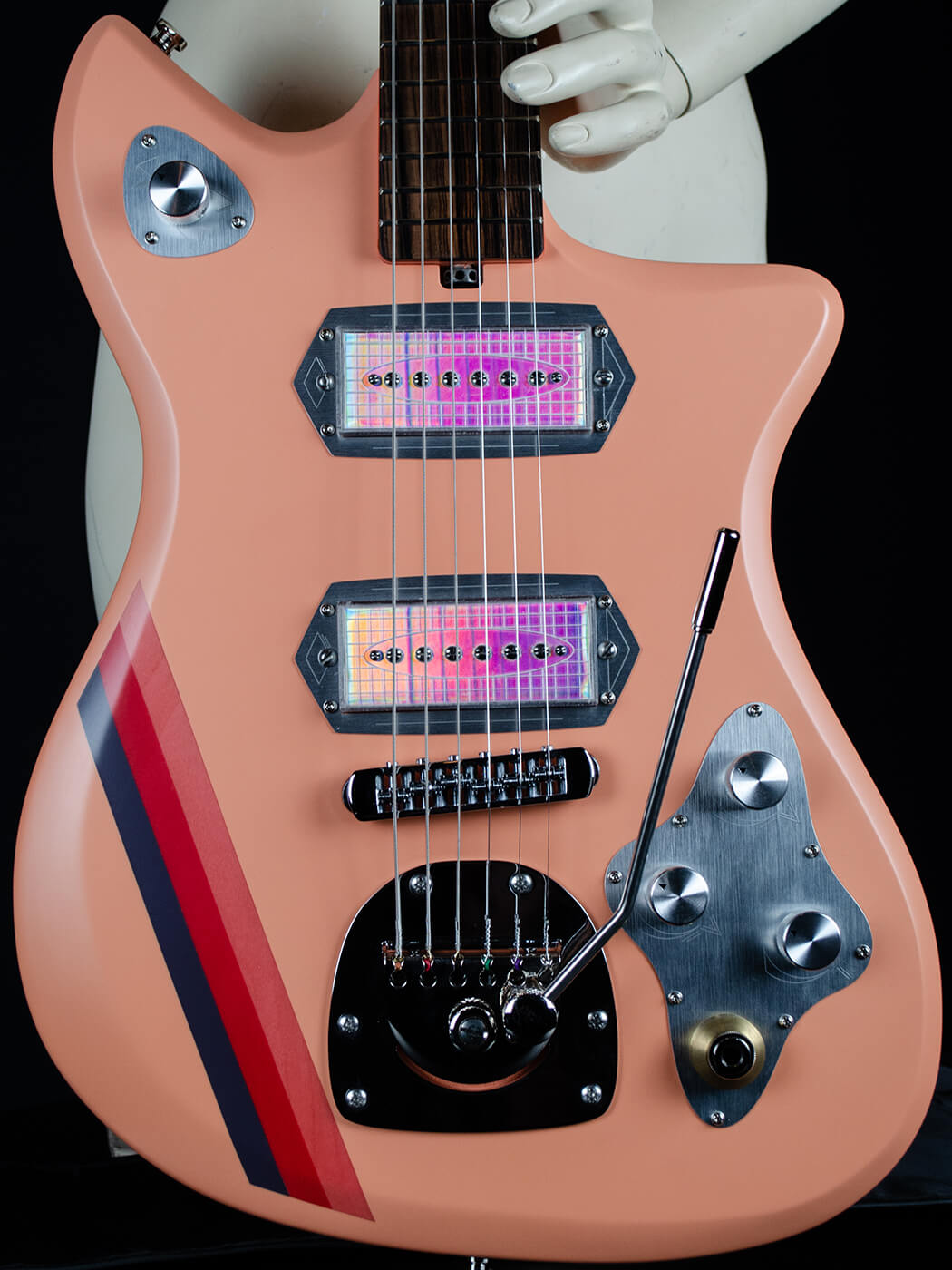Related Tags
Shop Talk: Mike Baranik of Baranik Guitars on how an acclaimed acoustic luthier became one of the hippest electric builders around
Mike Baranik’s line of retro-inspired reworkings of 1960s catalogue-style guitars might have caught a few fans off guard, but the results are no less breathtaking than expected.

Like many of today’s noteworthy guitar makers, Mike Baranik’s interest in the instrument began as a young player. Unlike so many musicians, however, his sideways leap into a proper course of training in the craft of building the instruments came out of an epiphanic blast of common sense.
Baranik was born on Vandenberg Air Force Base in Lompoc, California, in the early 1970s – and the westward lean of the US guitar industry would lure him back that way in later years. He grew up on the opposite coast, however, in Vernon, New Jersey, the location of the notorious Action Park water and amusement park – nicknamed “Accident Park” and documented in the feature The Rise and Fall of Action Park, New Jersey’s Most Dangerous Water Park on the History Channel – where he worked for three summers as a teenager. His real motivation, however, had nothing to do with wild rides or waterborne infections.
“I was a teenager in the mid-80s,” Baranik tells us, “and it was really hard not to be interested in the guitar at the time. I got my first guitar from the Sears catalog, a right-handed Flying V. I’m a lefty but I’m a bit ambidextrous, so when I couldn’t find a lefty guitar I decided to teach myself how to play right handed. It was definitely a hard thing to do, especially using my right hand for picking and learning Van Halen and Satriani licks.
“I spent most of my time obsessing over practicing and playing. I also would take apart my guitars to see how they worked and was really interested in tremolos and the electronics. We had a family vacation to California when I was 17, and while in Los Angeles we toured Musicians Institute and my friend and I saw Satriani at the Roxy on the Surfing With The Alien tour, and I thought, ‘This is it, I’m moving to LA and going to GIT [the Guitar Institute of Technology] after high school!’”

A wake-up call
Baranik moved to LA in his late teens and got a job working at the legendary Tower Records shop on Sunset Strip while preparing to attend GIT. But even this early exposure to the scene unveiled just how many talented guitarists were already pounding the pavement in Tinseltown looking for work. “I realised that this wasn’t the smartest career path,” he recalls.
“One day I was flipping through a guitar magazine and saw an ad for the Roberto-Venn School Of Luthiery in Phoenix, Arizona. I didn’t even realise you could build guitars; I thought that they just came from a factory, and it really intrigued me. I got a brochure, applied to the school, and attended in the fall of 1993. I was super-nervous, with very little woodworking experience, but that didn’t really matter. Once I started learning I was hooked, I absolutely loved it and the four-month course just flew by.”
After completing the course, Baranik begged the head instructor, John Reuter, to allow him to stay on as an apprentice – a position that also led to a wealth of guitar-repair experience – and six months later he was hired as an assistant instructor for a few classes. From there, he landed a job building for a new local maker called Phoenix Guitar Company, where in addition to focusing on electrics he started learning the craft of acoustic guitar making from his friend and roommate, Kent Hamblin.
Phoenix closed down after only a year, but the shop-foreman position Baranik then landed at a local woodworking store might have been the best thing that could have happened at that stage in his career. “I learned some new woodworking skills,” he says, “but I think what I really learned was about the different types of wood and spent most of my paycheck on buying exotic woods. Physically it was a really tough job, and one of the customers offered me a position at his high-end furniture studio with better pay and access to the shop, so I accepted.”

The golden age of luthiery
The facilities and the proximity to a lot of great wood accelerated Baranik’s move into acoustic guitars, and after several months pursuing the effort on the side he completed two flat-tops to take to an acoustic-guitar festival in California:
“This was 1997, and it was pretty much perfect timing… the start of the golden age of luthiery. I showed up and attended some workshops, Jim Olson had one of his jigs and was demonstrating his building techniques, and I asked pretty much every luthier if they would look at my guitars. I got some amazing feedback and really enjoyed the show, so I basically decided to start my business right after. It was similar to going to California in the 80s, deciding instantly, ‘this is it I’m going to start making acoustic guitars for a living!’”
And make he did. Baranik earned a top-flight reputation impressively quickly, along with a long wait list for orders. In 2006 he moved the business from Arizona to California, and was still in a full-on acoustic obsession until around 2012 when he “started thinking about making an electric again.”
“I also really started getting into bands that used lots of pedals,” he says, “and it really made me want to start playing guitar again. Also, there was a connection to when I first started building guitars, which were electrics, so it was kind of a homecoming but also maybe a bit of nostalgia creeping in, a return to my youth. I think that, for me, doing both acoustics and electrics has brought that excitement back into building. A breath of fresh air. I’ve also connected with some musicians that I’ve been a huge fan of, and working with them has been an amazing experience. Especially this past year with no live concerts, to have my guitars being used on TV and live streams has really kept me going.”

Pawnshop chic
Baranik’s not the only maker to have transitioned from an acoustic-only workshop to also crafting solidbody electrics, but when most top-tier luthiers go that route they tend to embrace some of the same tradition and refinement in their electrics – much as we saw with Collings’s venture into those territories in the 2000s, for example. Baranik, on the other hand, has gone all in on the quirky B-list charms of the Japanese and Italian budget beauties of the 60s in his solidbodies. Which is not to say they don’t have an elegance and refinement of their own, but they’re definitely coming at us from way out of left field.
“I have always loved the weird guitars that just had their own personality,” he says. “The problem with a lot of those guitars, though, especially the ones from Japan, is that they are usually hard to play. I have a couple Teisco guitars and they look and sound amazing but the necks are really thick, there’s no truss rod, the frets are uneven, the hardware isn’t so great. So, I take a lot of inspiration from these guitars and design something that looks along those lines, but then give it the best possible playability and tonal options.
“Playability and tone are paramount. Looks and designs are extremely important but if a guitar doesn’t play and sound great what’s the point? Things like neck shape, weight balance, and ergonomics might not be immediately apparent but are vital for the player to have the best playing experience. The guitar should be an extension of the player. I try to keep the weight down on my electrics, from five and a half to six and a half pounds depending on the model. And there’s lots of little variables that, when they are added up, will make my guitars their own thing: neck pitch, neck shape, body contours, and so forth.”

Going for gold
The maker himself is perhaps too modest to mention the ridiculously clever offset-three-a-side headstock in his bolt-neck B1 solidbody – a modernistic touch that somehow sits perfectly with the otherwise retro nature of the design – but it is perhaps one of this increasingly popular guitar’s most distinctive features. More than just an eye-catcher, and enabling a straight-line string pull, does it serve some other functional purpose?
“Oh man, thanks for asking,” Baranik replies. “The headstock design was really important for me for a couple reasons: I really wanted something that would be totally original but also have form follow function. I really like reverse string pull as it adds tension to the bass strings, making those strings less likely to buzz, especially with a shorter scale, while making the treble strings easier to bend with less tension. It was also important that it would be unique and act as an identifier. I was not sure how people would react, but the response to it has been amazing.”
The truth is, though, just about everything on Baranik’s solidbody models is distinctive, from hardware to pickups to body shapes and beyond, yet each is comfortably appealing and easy to like. Not odd or alien, but original, refreshing, and approachable.
“I think choice of hardware can make or break a design,” says Baranik, “whether it’s pickups, bridges, or even knobs. I also try to use stuff that’s maybe not the number one choice that’s on every single guitar out there. It can be challenging to find components that are not on everyone’s radar and at the same time are high quality. It has led me to making some of my own hardware, which is pretty exciting and does add a level of uniqueness that can set my guitars apart. I just bought a 30-ton press and I’m really excited to start press-forming some metal parts!”
After concerns about running out of the vintage gold foils and lipstick-tube pickups used on some of his early examples, Baranik discovered the similarly inspired creations of UK winder Mojo Pickups, and these acclaimed units have helped his guitars to further stand out.
“I was instantly attracted to the idea of using pickups that were new stock but based on retro designs,” he tells us. “Marc from Mojo has been great to work with and has customised pickups to my specs. I pulled apart a certain lipstick pickup to try and give Marc the most amount of information to make a copy, and it kickstarted the idea to try to make my own pickups.
“I took apart some old gold foils and studied the construction and designed my own… after about the first 10 prototypes I had something I really felt captured the gold-foil spirit but had its own voice as well. I’m starting to make a few other pickups, including my own lipstick, and I have this really cool humbucker that’s almost done. So, I’ve really been enjoying the experience.”

Paint shop
Another standout feature on the B1 and RE1 is one of the simplest: the paint. But nothing’s quite so straightforward as it might seem in the world of Baranik. Eschewing the popular palette seen on so many other guitars, he goes the extra mile to keep the look original, custom-mixing his paint rather than ordering stock colours.
“I like to take inspiration from anything that catches my eye,” he tells us. “The Gina B1 was colour-matched to a vintage Regina two-tone pink floor scrubber that I found at a garage sale and just had to buy. I have been using ultraviolet-cured finishes for quite a while, which really speeds up the process. I’m using a UV-cured acrylic satin topcoat as I think the low gloss adds a nice feel and look to the vibrant colours.”
Other than designing and crafting the guitars themselves, one of Baranik’s greatest pleasures comes from the opportunity of working with artists that he respects. And as his reputation continues to grow, that’s something he’s enjoying more and more of.
“I have really been inspired to work with musicians who are interested in or are already pushing boundaries,” he relates. “Things were already moving towards that before COVID, but I believe the pandemic has really opened up some connections with musicians who might have not had the time to even think about exploring new gear otherwise.
“I’m just finishing up a guitar for [LA session guitarist] Mason Stoops, who I think is one of the best players in the newer generation of guitarists. He’s had the RE1 prototype with him since August and it’s gotten exposed to so many players, including Harrison Whitford [Phoebe Bridgers] and Ryan Lerman [Ben Folds, Michael Buble, Scary Pockets]. I asked Mason to get feedback on the prototype and he really delivered, showing it and using it all over Los Angeles, and as a bonus Harrison has used it on Saturday Night Live and The Late Show With Stephen Colbert, and Ryan has used it with Scary Pockets.”
Baranik tells us he’s also currently working on a guitar for Ruban Nielson of Unknown Mortal Orchestra, “which feels so surreal! I think Ruban is the definition of a modern-day guitar hero and is always looking to evolve his playing and sound. I can’t wait for live music to start coming back and start seeing some of these guitars being in a live situation. Also, Brad Shultz from Cage the Elephant just got one of my guitars and I’m really looking forward to seeing him use it – he promised me he wouldn’t smash it!”
Follow @baranikguitars on Instagram for more.
